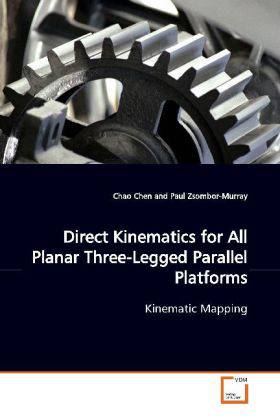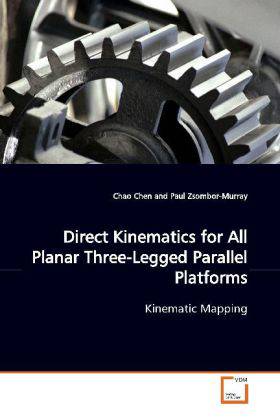
- Afhalen na 1 uur in een winkel met voorraad
- Gratis thuislevering in België vanaf € 30
- Ruim aanbod met 7 miljoen producten
- Afhalen na 1 uur in een winkel met voorraad
- Gratis thuislevering in België vanaf € 30
- Ruim aanbod met 7 miljoen producten
Zoeken
Direct Kinematics for All Planar Three-Legged Parallel Platforms
Kinematic Mapping
Chao Chen
Paperback | Engels
€ 48,45
+ 96 punten
Omschrijving
Kinematic mapping is a valuable tool to deal with
difficult direct kinematics problems. It should have
successful application in other areas of kinematics
as well. However, it has been ignored by most
engineers. One reason may be that it is rooted in
19th century projective geometry, while most
engineers are familiar only with the older,
traditional Euclidean geometry. Hence, many
reject kinematic mapping at the first glance when
confronted by its peculiar, sometimes intuitively
unrealistic, possibly confusing and overly
complicated concepts. It is humbly suggested
that we might initially avoid the details of the
basic geometry in order not to scare off potential
users when introducing them to kinematic mapping.
The authors found this tool to be easy to use
but difficult to understand. Therefore, it may
obtain wider acceptance if we focus first on actual
applications before becoming enmeshed deeply in the
theoretical background.
difficult direct kinematics problems. It should have
successful application in other areas of kinematics
as well. However, it has been ignored by most
engineers. One reason may be that it is rooted in
19th century projective geometry, while most
engineers are familiar only with the older,
traditional Euclidean geometry. Hence, many
reject kinematic mapping at the first glance when
confronted by its peculiar, sometimes intuitively
unrealistic, possibly confusing and overly
complicated concepts. It is humbly suggested
that we might initially avoid the details of the
basic geometry in order not to scare off potential
users when introducing them to kinematic mapping.
The authors found this tool to be easy to use
but difficult to understand. Therefore, it may
obtain wider acceptance if we focus first on actual
applications before becoming enmeshed deeply in the
theoretical background.
Specificaties
Betrokkenen
- Auteur(s):
- Uitgeverij:
Inhoud
- Aantal bladzijden:
- 80
- Taal:
- Engels
Eigenschappen
- Productcode (EAN):
- 9783639150377
- Uitvoering:
- Paperback
- Afmetingen:
- 150 mm x 219 mm
- Gewicht:
- 124 g

Alleen bij Standaard Boekhandel
+ 96 punten op je klantenkaart van Standaard Boekhandel
Beoordelingen
We publiceren alleen reviews die voldoen aan de voorwaarden voor reviews. Bekijk onze voorwaarden voor reviews.








